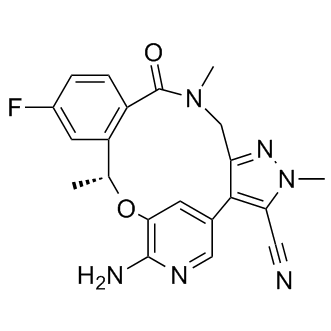| Description: |
Lorlatinib is a potent, dual ALK/ROS1 inhibitor, with Kis of 0.02 nM, 0.07 nM, and 0.7 nM for ROS1, wild type ALK, and ALK-L1196M, respectively. |
| In Vivo: |
In rats, Lorlatinib displays low plasma clearance, a moderate volume of distribution, a reasonable half-life, low propensity for p-glycoprotein 1-mediated efflux and a bioavailability of 100%[1]. In vivo, Lorlatinib shows cytoreductive antitumor efficacy in the NIH3T3 xenograft models expressing human CD74-ROS1 and Fig-ROS1 via inhibition in ROS1 phosphorylation and the downstream signaling molecules, as well as inhibition of the cell cycle protein Cyclin D1 in tumors[2]. In vivo, Lorlatinib also demonstrates marked antitumor activity in mice bearing tumor xenografts expressing EML4-ALK, EML4-ALK-L1196M, EML4-ALK-G1269A, EML4-ALK-G1202R or NPM-ALK[3]. |
| In Vitro: |
Lorlatinib demonstrates significant cell activity against ALK and a large set of ALK clinical mutations with IC50 ranging from 0.2 nM-77 nM[1]. Lorlatinib significantly inhibits cell proliferation and induces cell apoptosis in the HCC78 human NSCLC cells harboring SLC34A2-ROS1 fusions and the BaF3-CD74-ROS1 cells expressing human CD74-ROS1[2]. Lorlatinib also shows potent growth inhibitory activity and induces apoptosis in the NSCLC cells harboring either non-mutant ALK or mutant ALK fusions[3]. |






















